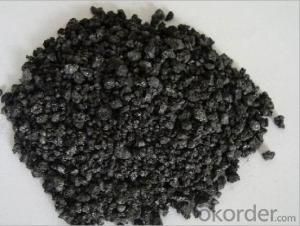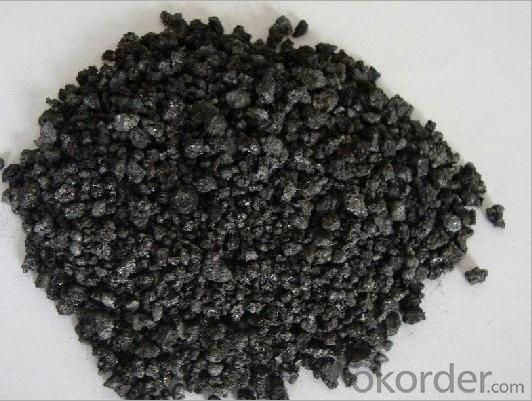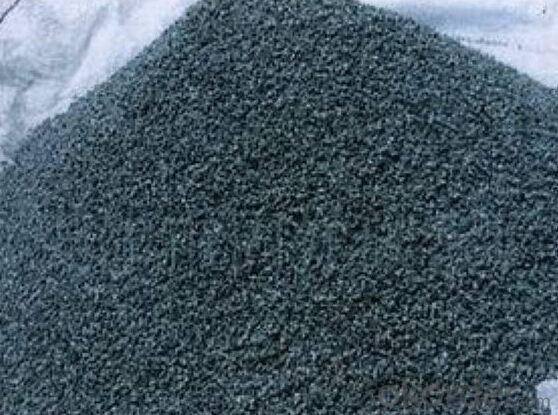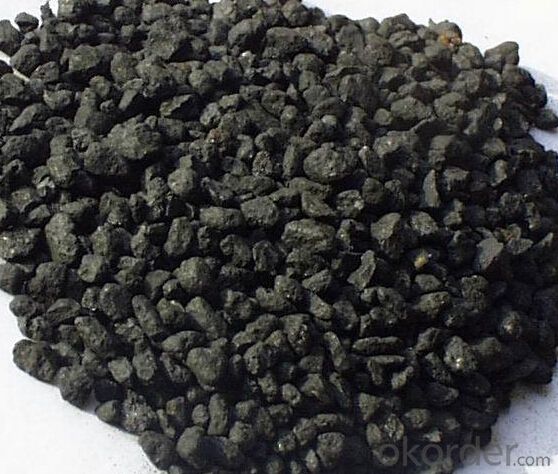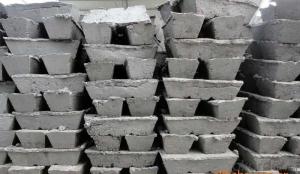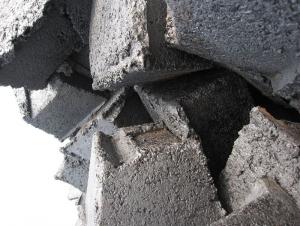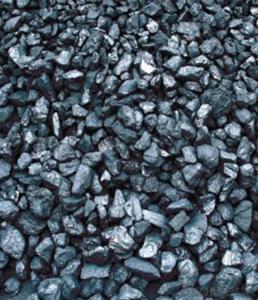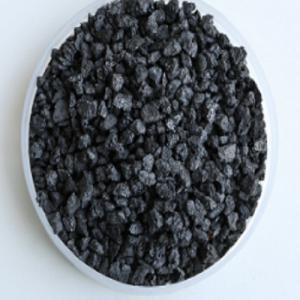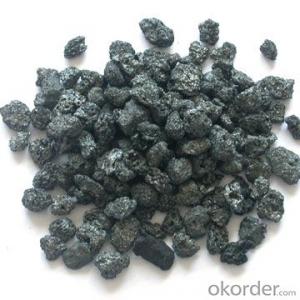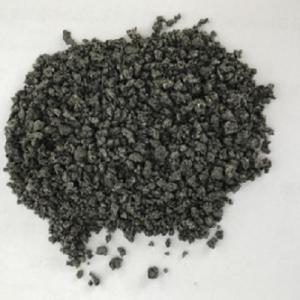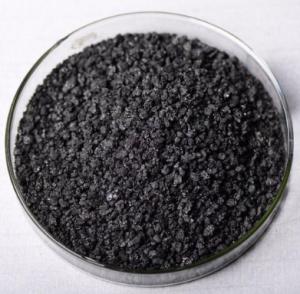Calcined Petroleum Coke High Quality
- Loading Port:
- Tianjin
- Payment Terms:
- TT or LC
- Min Order Qty:
- 20 m.t.
- Supply Capability:
- 3000 m.t./month
OKorder Service Pledge
OKorder Financial Service
You Might Also Like
Quick Details
Place of Origin: Hebei, China (Mainland)
Application: aluminium industry and carbon industry
Chemical Composition: Density 2.04g/cm3
Packaging & Delivery
| Packaging Details: | 25kg/bag 50kg/bag 200kg/bag 1000kg/bag Or according with client needs |
|---|---|
| Delivery Detail: | 2 weeks |
Specifications
Calcined Petroleum Coke High Quality
Petroleum coke products can be divided into needle coke, sponge coke, projectile coke and coke breeze four kinds.
Calcined Petroleum Coke
F.C.: 98.5%MIN
ASH: 0.8% MAX
V.M.: 0.7%MAX
S:0.5%MAX
Moisture: 0.5%MAX
Structure
Calcined Petroleum Coke High Quality
Shape: granule
- Dimensions: 0-1mm, 1-5mm, 1-6mm, 2-8mm, etc
- Product Type: Carbon Additive
- C Content (%): 98-99.5% MIN
- Working Temperature: -
- S Content (%): 0.5%-0.7%MAX
- Ash Content (%): 0.7%MAX
- Volatile:0.8%MAX
- Moisture: 0.5% MAX
- ADVANTAGE: low ash & sulfur
- COLOR: Black
Feature
Calcined Petroleum Coke High Quality
Physics and chemistry performance :
Unit | Index | |||||
No.1 | No.2 | No.3 |
| |||
Density | g/cm3 | 2.04 | 2.00 | 2.00 | ||
sulphur content | %≤ | 0.5 | 1.0 | 2.5 | ||
volatility | %≤ | 0.5 | 0.5 | 0.5 | ||
ash content | %≤ | 0.5 | 0.5 | 0.5 | ||
moisture | %≤ | 0.3 | 0.5 | 0.5 | ||
charcoal | %≤ | 98.5 | 98.0 | 98.0 | ||
Image
Calcined Petroleum Coke High Quality
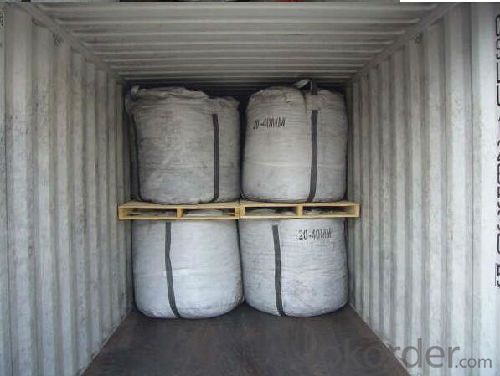
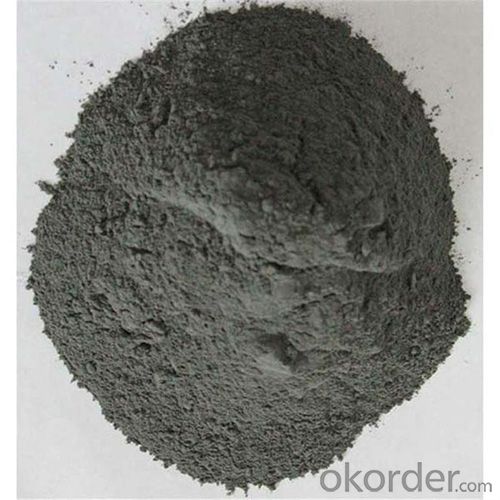
FAQ:
Calcined Petroleum Coke High Quality
How to classify calcined petroleum coke?
1) According to difference of sulfur content, can be divided into high sulfur coke (sulfur content more than 4%), sulphur in coke sulfur content (2% 4%) and low sulfur coke (sulfur content below 2%).
2) Petroleum coke products can be divided into needle coke, sponge coke, projectile coke and coke breeze four kinds:
3) Needle coke, has obvious needle-like structure and fiber texture, mainly used for steel-making in high power and ultra-high power graphite electrode. As a result of needle coke in sulfur content, ash content, volatile matter and true density and so on have strict quality requirements, so the production process of needle coke and raw materials have special requirements.
4) The sponge coke, high chemical reactivity, low content of impurities, mainly used in the aluminum industry and carbon industry.
5) Focal or spherical coke: the projectile shape is round, diameter 0.6-30 mm, usually from the production of high sulphur, high asphaltic residual oil, can only be used as industrial fuel power generation, cement etc.
6) Coke breeze: fluidized coking process, the fine particles (0.1- 0.4 mm) in diameter, high volatile, high expansion coefficient, cannot be directly used for electrode preparation and carbon industry.
Advantage:
Calcined Petroleum Coke High Quality
1. High quality and competitive price.
2. Timely delivery.
3. If any item you like. Please contact us.
Your sincere inquiries are typically answered within 24 hours.
- Q: How is carbon used in the production of pharmaceuticals?
- Carbon is used in the production of pharmaceuticals through various processes such as carbonization, activation, and purification. It serves as a crucial component in the synthesis of drugs and plays a significant role in drug formulation, purification, and separation processes. Additionally, carbon-based materials are utilized as drug carriers and adsorbents to enhance drug delivery and optimize the efficiency of pharmaceutical manufacturing.
- Q: How are carbon compounds classified?
- Carbon compounds are classified based on the type and number of atoms bonded to carbon atoms. There are several categories of carbon compounds that include hydrocarbons, alcohols, aldehydes, ketones, carboxylic acids, esters, ethers, amines, amides, and many more. Hydrocarbons are carbon compounds that only contain carbon and hydrogen atoms. They can be further divided into two main categories: aliphatic hydrocarbons and aromatic hydrocarbons. Aliphatic hydrocarbons include alkanes, alkenes, and alkynes, which are classified based on the type of carbon-carbon bonds they have. Aromatic hydrocarbons, on the other hand, contain a ring structure and are known for their aromaticity. Alcohols are carbon compounds that contain a hydroxyl (-OH) group attached to a carbon atom. They are classified based on the number of hydroxyl groups attached to the carbon atom. For example, methanol is a monohydroxy alcohol, while ethylene glycol is a dihydroxy alcohol. Aldehydes and ketones are carbon compounds that contain a carbonyl group (C=O). Aldehydes have the carbonyl group attached to a terminal carbon atom, while ketones have it attached to an internal carbon atom. They are named based on the number and position of the carbonyl group in the molecule. Carboxylic acids are carbon compounds that contain a carboxyl group (-COOH). They are named by replacing the -e ending of the corresponding hydrocarbon with -oic acid. For example, methane becomes methanoic acid. Esters are carbon compounds that are derived from the reaction between a carboxylic acid and an alcohol. They have the general formula RCOOR’, where R and R’ can be any alkyl or aryl group. They are often named based on the alcohol and acid used to form them. Ethers are carbon compounds that have an oxygen atom bonded to two alkyl or aryl groups. They are named by listing the alkyl or aryl groups in alphabetical order followed by the word ether. Amines are carbon compounds that contain a nitrogen atom bonded to one or more alkyl or aryl groups. They are named by adding the suffix -amine to the name of the alkyl or aryl group attached to nitrogen. Amides are carbon compounds that contain a carbonyl group (C=O) bonded to a nitrogen atom. They are named by replacing -oic acid or -ic acid ending of the corresponding carboxylic acid with -amide. Overall, the classification of carbon compounds is based on their functional groups and the arrangement of atoms around the carbon atom. These classifications help to categorize and study the diverse range of carbon compounds found in nature and synthesized in the laboratory.
- Q: What are the challenges of carbon capture and storage technology?
- Carbon capture and storage (CCS) technology shows promise as a solution for reducing greenhouse gas emissions and combating climate change. Nevertheless, there are various obstacles that must be overcome in order for it to be widely adopted and effective. One of the primary hurdles associated with CCS technology is its considerable cost. The implementation of CCS necessitates significant investments in infrastructure, equipment, and operations, making it economically burdensome. Additionally, the capture process itself requires substantial amounts of energy, resulting in increased costs and potentially limiting its feasibility. Another challenge pertains to the limited capacity for storage. Identifying suitable underground sites for storing the captured carbon dioxide (CO2) is crucial, but can be difficult due to geological limitations. The task of identifying and evaluating suitable sites with adequate storage capacity is complex and necessitates meticulous planning. Furthermore, concerns exist regarding the long-term stability and integrity of the storage sites. Leakage of stored CO2 could compromise the effectiveness of CCS and pose environmental risks. Ensuring the secure and safe storage of captured carbon is essential to prevent any adverse impacts on ecosystems and public health. Transporting the captured CO2 from the capture sites to the storage facilities also presents a challenge. Establishing an efficient and extensive transportation infrastructure is necessary for the widespread implementation of CCS technology. Developing pipelines or other means of transportation capable of handling the volume of captured CO2 and ensuring its secure transport over long distances is crucial. Public acceptance and social factors also significantly impact the challenges associated with CCS technology. Local communities may have concerns and objections regarding potential risks associated with the capture, transport, and storage of CO2. Effectively addressing these concerns through transparent communication and engagement with stakeholders is vital for garnering public support and minimizing opposition. In conclusion, carbon capture and storage technology has the potential to greatly reduce greenhouse gas emissions. However, its challenges, including high costs, limited storage capacity, integrity concerns, transportation infrastructure, and public acceptance, must be addressed to ensure successful implementation and make a significant contribution to mitigating climate change.
- Q: What are fossil fuels and how are they formed?
- Fossil fuels are natural energy resources derived from the remains of ancient plants and animals that lived millions of years ago. They are formed through a long process involving the decomposition and conversion of organic matter under high pressure and temperature over geological time. This transformation results in the formation of coal, oil, and natural gas, which are the primary types of fossil fuels.
- Q: How does carbon affect the pH of rainwater?
- The pH of rainwater can be influenced by carbon, which occurs when carbon dioxide (CO2) in the atmosphere dissolves in rainwater. This process is known as the formation of carbonic acid (H2CO3). As a result of this reaction, the pH of rainwater decreases, making it more acidic. The carbonic acid breaks down into hydrogen ions (H+) and bicarbonate ions (HCO3-), which further contribute to the acidity of rainwater. Consequently, higher levels of carbon dioxide in the atmosphere, such as those caused by human activities like the combustion of fossil fuels, can result in an increase in the formation of carbonic acid and subsequently lower the pH of rainwater, leading to the occurrence of acid rain.
- Q: How is carbon dating used to determine the age of fossils?
- Carbon dating is a scientific method that scientists use to figure out how old fossils and other organic materials are. It works because there is a special type of carbon called carbon-14 that is in the air and gets absorbed by living things when they're alive. When an organism dies, it stops taking in carbon-14 and the amount of it starts to go down over time as it breaks down. To find out the age of a fossil using carbon dating, scientists first take a small piece of the fossil. They then treat this piece with chemicals to get rid of any impurities and get the carbon out of the organic material. The carbon that is extracted is then turned into carbon dioxide gas, which is used to make graphite targets for measuring the levels of carbon-14. Scientists use a technique called Accelerator Mass Spectrometry (AMS) to count how many carbon-14 and carbon-12 atoms are in the sample. They then use the ratio of carbon-14 to carbon-12 to figure out how old the fossil is, based on the known half-life of carbon-14, which is about 5730 years. By comparing the amount of carbon-14 left in the fossil to the amount of carbon-14 in the air when the organism died, scientists can estimate the approximate age of the fossil. This method is especially useful for dating organic materials that are up to around 50,000 years old. For older fossils, scientists usually use other methods like potassium-argon dating or uranium-lead dating.
- Q: What is coal?
- Coal, a sedimentary rock primarily composed of carbon, is black or brownish-black in color and contains various other elements such as hydrogen, sulfur, oxygen, and nitrogen. It forms from the remains of plants that lived and died millions of years ago, accumulating in swampy environments. Over time, the layers of plant material experience high pressure and heat, resulting in coal formation. As one of the most abundant fossil fuels on Earth, coal has been utilized as an energy source for centuries. It is typically extracted from underground or surface mines and exists in different forms, including anthracite, bituminous, sub-bituminous, and lignite, each with varying carbon content and heating value. Due to its high carbon content, coal is primarily employed for electricity generation and fueling industrial processes. When burned, it releases heat energy that is converted into electricity through the utilization of steam turbines. Nevertheless, the combustion of coal also emits greenhouse gases and other pollutants, contributing to air pollution and climate change. Apart from its use as a fuel, coal finds application in the production of steel and cement, as well as various industrial processes. It is a versatile resource that has played a pivotal role in the advancement of modern societies. However, its environmental impact and finite nature have spurred efforts to transition towards cleaner and more sustainable energy sources.
- Q: How can carbon be stored underground?
- Carbon can be stored underground through a process called carbon capture and storage (CCS). This involves capturing carbon dioxide (CO2) emissions from industrial sources, such as power plants or cement factories, and then storing it deep underground in geological formations. The first step in this process is capturing the CO2 emissions before they are released into the atmosphere. There are several technologies available for this, including post-combustion capture, pre-combustion capture, and oxy-fuel combustion. These technologies separate the CO2 from other gases, such as nitrogen, and produce a concentrated stream of CO2 that can be easily stored. Once the CO2 is captured, it needs to be transported to a suitable storage site. This is typically done through pipelines or ships, depending on the distance and the location of the storage site. The CO2 is then injected deep underground into geological formations, such as depleted oil and gas reservoirs, saline aquifers, or coal seams. The storage sites are carefully selected based on their ability to securely and permanently store the CO2. The geological formations must have a layer of impermeable rock above them, known as a caprock, to prevent the CO2 from leaking back to the surface. The sites are also monitored regularly to ensure the stored CO2 remains securely underground. Storing carbon underground can significantly reduce CO2 emissions and help mitigate climate change. It effectively prevents the release of CO2 into the atmosphere, where it would contribute to the greenhouse effect and global warming. Furthermore, CCS can be combined with enhanced oil recovery (EOR) techniques, where the injected CO2 is used to extract more oil from depleted reservoirs, making the process economically viable. However, it is important to note that carbon storage is not a permanent solution to climate change. It can play a role in reducing emissions while transitioning to cleaner energy sources, but it should not replace efforts to decarbonize the economy and reduce reliance on fossil fuels. Additionally, the long-term safety and environmental impacts of storing carbon underground need to be thoroughly studied and understood to ensure its effectiveness and sustainability.
- Q: What are some natural sources of atmospheric carbon emissions?
- Some natural sources of atmospheric carbon emissions include volcanic eruptions, forest fires, and decomposition of organic matter. Volcanic eruptions release large amounts of carbon dioxide and other greenhouse gases into the atmosphere. Forest fires also release carbon dioxide when trees and vegetation burn. Additionally, the decomposition of organic matter such as dead plants and animals in forests, wetlands, and oceans produces carbon dioxide as a natural byproduct. These natural sources of atmospheric carbon emissions have been occurring for millions of years and play a crucial role in the carbon cycle, which helps regulate Earth's climate.
- Q: What are the main factors that affect the strength of carbon fibers?
- The main factors affecting the strength of carbon fibers arePAN precursorPreoxidationcarbonizationGraphitizationsurface treatmentCoilingcarbon fibre
Send your message to us
Calcined Petroleum Coke High Quality
- Loading Port:
- Tianjin
- Payment Terms:
- TT or LC
- Min Order Qty:
- 20 m.t.
- Supply Capability:
- 3000 m.t./month
OKorder Service Pledge
OKorder Financial Service
Similar products
Hot products
Hot Searches
Related keywords
